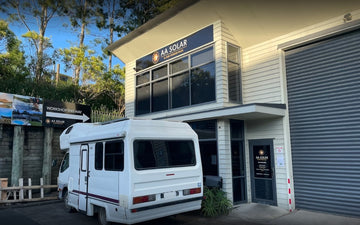Solar Photovoltaic (PV) panels are susceptible to the effect of shading. Shading obstructions can be defined as soft or hard sources. The shadow is diffused or dispersed if a tree branch or roof rack is shading from a distance. These soft sources significantly reduce the amount of light reaching a solar PV panel's cell(s). Hard sources stop light from reaching the cell(s), such as a tree branch, a bird dropping, or a bird sitting directly on top of the glass. Unlike a solar thermal panel, which can tolerate some shading, many brands of solar PV panels cannot take being shaded by the branch of a leafless tree. Many methods are used today to mitigate this shading effect, including bypass diodes, DC-optimisers, micro-inverters, half-cut solar cell configurations in PV modules, & software optimisation in string inverters. It is always best to avoid shading altogether, but sometimes it is unavoidable. Hence, it is fortunate that alternative methods are available to mitigate the effect of shading in solar PV installations.
The water flow analogy of shading on standard full-cell PV modules in a string of panels. Under normal circumstances, the flow rate of water (in a pipe) and current (in the string of PV cells/panels) is constant. Shading a solar PV cell is like introducing a clog in a pipe. How a clog in the pipe will restrict water flow, a shaded solar cell will limit current flow in the series connection of cells. Therefore, a small amount of shading can dramatically impact the power output of a solar PV panel.
Partially shading even one cell of a 36-cell solar panel (e.g. our AAS-85W) will reduce its power output. Because all the cells are connected in a series string, the weakest cell will bring the others down to its reduced power level. When a full cell is shaded, it can act as a consumer of energy produced by the remainder of the cells and trigger the module to protect itself via bypass activation. The module will route the power around that series string. If even one whole cell in a series string is shaded, it will most likely cause the module to reduce its power level to half or a third of its full available value, depending on the number of bypass segments in the module. If a row of cells at the bottom of a module is fully shaded, the power output may drop to zero for modules using full-cell configurations. The best way to avoid loss in output power is to avoid shading whenever possible.
When a whole cell is shaded, it can act as a consumer of energy produced by the remainder of the cells and trigger the module to protect itself. The module will route the power around that series string. If even one whole cell in a series string is shaded, it will most likely cause the module to reduce its power level to half of its total available value. The power output may drop to zero if a row of cells at the bottom of a module is fully shaded.
The best way to avoid a drop in output power is to avoid shading whenever possible.

Example of full cell shading that can reduce Solar Panel output power to ZERO

Example of full-cell shading that can reduce Solar Panel output power by HALF
Various techniques are used to mitigate shading effects in PV systems today. In a string, an alternative route is available that bypasses that panel or segment (via bypass diodes). This avoids collecting the power that could be generated in that panel or segment to maintain the current flow from the remainder. Almost all modules come out of the factory with bypass diodes pre-installed. Designers also use selective arrangements to best suit the installation location to minimise or avoid shading.

Example of bypass diodes on segments of a PV module.
Module-level power electronics (MLPEs) also improve module performance under shaded conditions. MLPEs can be used in the form of DC-optimisers and microinverters. Such devices provide other advantages, such as monitoring power generation at the module level. DC-optimisers adjust their output voltage and current to maintain maximum power without compromising the module’s performance. Microinverters can be installed at each.
Module to perform MPPT and the inverter function. This provides an AC output that is connected in parallel, allowing each panel to operate independently. Although we can’t always eliminate the shading of solar PV panels, we can use modern optimisation methods and different techniques to minimise the effect of shading. Common practices such as microinverters can be used to reduce shading impacting an entire array of solar PV modules.

Individual modules are now also available in split/half-cut cell configurations. This is likely to become more and more common in the solar PV industry. This module configuration allows the top and bottom half of the module to operate independently, as shown below.
The shading loss is negligible in half-cut cell modules due to the difference in the current of the two halves. If one half is shaded, that area is affected, and the bypass diode of the half will be active, but the other half-cell segment is still in action, and that bypass diode is inactive. This is clear regarding the figure above, which shows the bypass diode as a red triangle. The power generation of the other half of the cell remains unaffected. Therefore, half-cut cells are preferred over standard cells in order to minimise shading losses. As strings are in a parallel configuration, the module can save up to 50% power in partial shading.
AA Solar can simulate the effects of shading and provide the most suitable system configuration for your next project. Call us on 09 887 9767 if you’d like to discuss a project.









